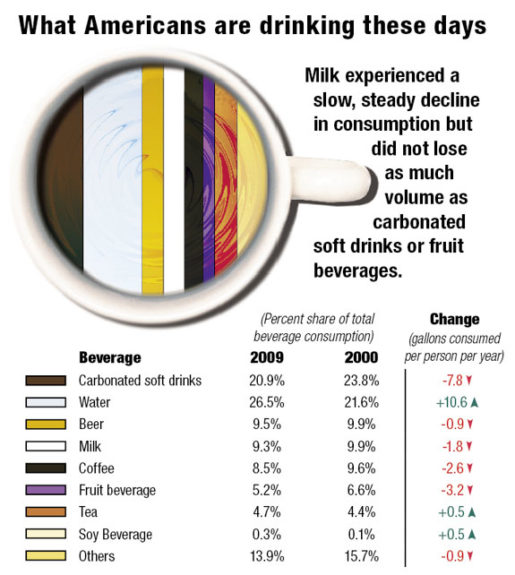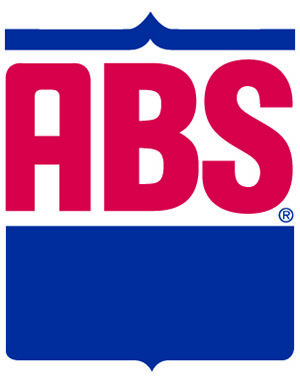Per capita U.S. milk consumption has declined nearly two gallons in the past decade due to increased consumption of water and alternative milk beverages and a decline in cereal consumption, a new study found. The U.S. fluid milk processor checkoff organization, or Milk Processor Education Program, known as MilkPEP, sponsored the comprehensive market research study released earlier this year. According to the study, at the beginning of the current decade, annual fluid milk consumption per person was 22.4 gallons. By 2009, consumption fell by 1.8 gallons to 20.6 gallons of milk per person per year. MilkPEP CEO Vivian Godfrey says the study showed clear winners and losers.
“Unfortunately, milk has been a loser,” Godfrey says. “People’s stomachs have not changed in size. So this really is a share game. If milk is going to grow, we have to stop losing shares. We have to at least maintain our gallons per person per year.”
Who are milk’s competitors?
Water. According to the study, water stole the most share from milk in the past decade, with more than a half-gallon increase consumed per person per year. Overall, the study found Americans drinking 10.6 gallons more water per year than in 2000.
“Water, in general, is viewed as healthy and neutral,” Godfrey says. “It’s not necessarily that it has anything terribly good going for it. But it doesn’t really have anything bad going for it – such as additives or sugars.”
Godfrey explains that much of the increase in water consumption is due to carbonated soft drink bottling giants Coca-Cola and Pepsi shifting their focus from marketing sugary drinks to bottled water.
“Because they have seen a decline in their core business, they have been happily buying up bottled water businesses in order to turn their giant marketing budgets toward encouraging consumers to buy bottled water,” Godfrey says.
Even toward the end of the survey period when the economy turned sour, consumers substituted tap water for bottled water, Godfrey notes.
“When families are facing tough times and they are struggling to have the paycheck last to the end of the month, tap water becomes an inexpensive beverage,” Godfrey says.
Alternative milks. While water has been stealing share from everyone, one particular beverage category has been growing steadily and taking share directly from the product of dairy farmers. These include soy, rice, coconut, hemp and other alternative milk brands.
To some extent, alternative milk brand competitiveness may have come from concerns with dairy milk, including lactose intolerance, animal well-being and the size of some dairy farm operations, which consumers also referenced as reasons why they were drinking fewer cups of cows’ milk.

Who are milk’s allies?
Coffee and tea. On average, consumers are drinking stronger blends of coffee and tea than a decade ago, Godfrey says, and that often means they will add more milk to them.
“Thank goodness for companies like Starbucks who have catered to our desire for new, different, fun, interesting beverages,” Godfrey says. “They have caused people to add more milk to their coffee.”
Cereal. Godfrey says cereal has alway been an ally of milk sales. But the bad news is that the category is declining. Next to the negative impact from water, the decline of cereal consumption was the second-largest explanation for a decrease in milk consumption, the study found. A lack of portability is to blame, Godfrey says.
“These days moms are rushing to get kids out the door and to the bus or popping them in the car and zipping them off to school,” Godfrey says. “And cereal with milk is not very portable. It’s much easier to give kids a toaster pastry or a cereal bar.”
Godfrey also notes that innovation in the cereal industry has been towards alternative cereal offerings and not in cereal varieties.

Milk’s future opportunities and challenges
The recent study also surveyed consumers about when and where they consumed milk beverages. Milk is an at-home beverage, Godfrey says to summarize the results.
“A really large portion of milk is consumed at some time of the day at home,” Godfrey says. “During a recession that is helpful because people tend to retrench back to eating more meals at home.”
Godfrey says her organization will be focusing on opportunities to increase milk consumption prior to and during breakfast.
“Many, many consumers tell us they love milk,” she says. “It’s always in their fridge, and they consider it to be a healthy beverage. But they sort of forget about it.
They need to be reminded that including a glass of milk with breakfast or dinner is going to turn any meal into a more healthy meal.”
Another recent survey completed by MilkPEP about the breakfast beverage habits of Americans showed that 17 percent of at-home drinks served at the first meal of the day were water and another 3 percent were a carbonated soft drink.
“That shocked me,” Godfrey says. “Who could possibly drink water or a soft drink for breakfast?”
Since 98 percent of U.S. refrigerators contain milk, Godfrey says this 20 percent of breakfast beverages could easily be replaced with milk. It’s the lowest-hanging opportunity for milk.
The second-best opportunity for increasing milk consumption, Godfrey says, is at dinner. And the third-best opportunity is to market chocolate milk to amateur adult athletes as a refuel beverage.
“We have some very nice scientific support showing that chocolate milk has a fantastic mix of carbohydrates, electrolytes and protein to be a very good refuel beverage after vigorous exercise,” Godfrey says.
Godfrey says MilkPEP has begun to use the research’s findings to build a strategy for increasing milk consumption. The first stage will promote drinking milk at meal time.
“Our major opportunity is to defend and enforce the already large milk consumption occasions in the home,” Godfrey says. PD

-
Walt Cooley
- Editor
- Email Walt Cooley








